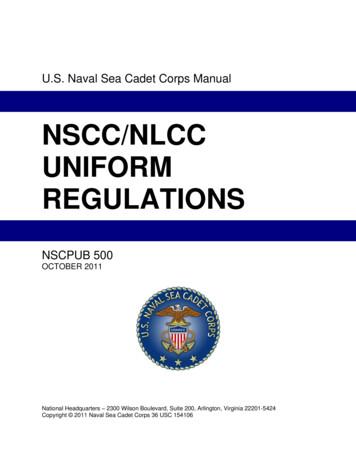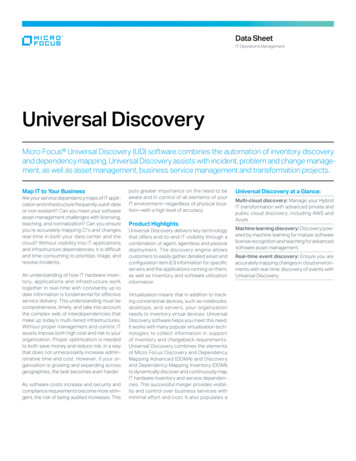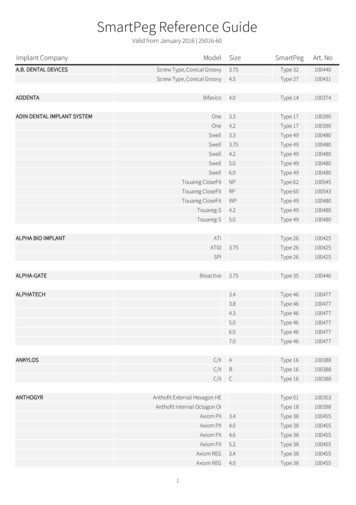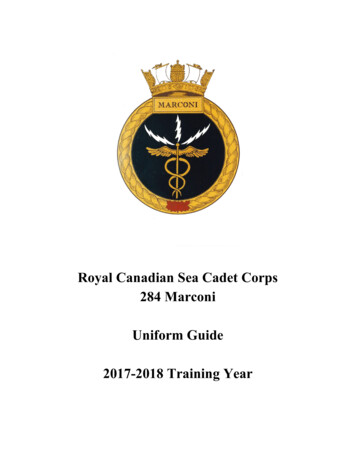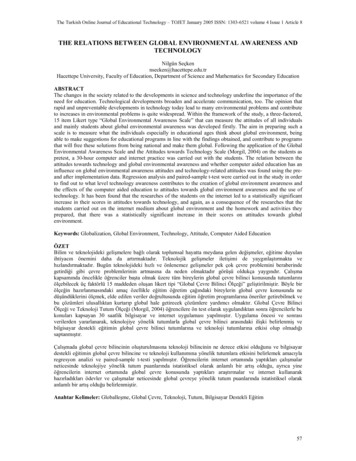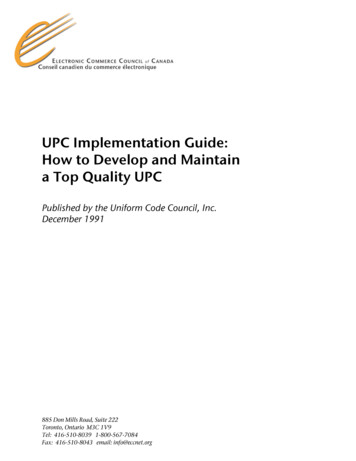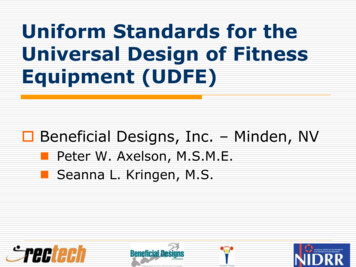
Transcription
Uniform Standards for theUniversal Design of FitnessEquipment (UDFE) Beneficial Designs, Inc. – Minden, NV Peter W. Axelson, M.S.M.E. Seanna L. Kringen, M.S.
Why Standardization?
Assistive TechnologyStandards (ATS) Provide clinicians and consumers with objectiveinformation Allow government agencies to set minimumperformance requirements Promote safe and quality products International standards reduce trade barriers Standards are under constant revisions due tochanging technology
Standards Organizations International Standards Organization(ISO) Rehabilitation Engineering andAssistive Technology Society of NorthAmerica (RESNA) – ANSI acredited ASTM
RESNA Standards Used as aModel RESNA Assistive TechnologyStandards (ATS) Committeesdevelop standards: Minimum safety criteria Minimum performance criteria
RESNA ATS Board Oversees RESNA Standards Committees for:WheelchairsWheelchair and Related SeatingWheelchairs and TransportationAssistive Technologies for Persons with VisualImpairments and Hearing and Visual Impairments Support Surfaces (mattress/overlay) Adaptive Sports Equipment Emergency Stair Travel Devises
RESNA Committees Consumers, organizations representingpeople with disabilities, researchers,practitioners, and manufacturers Develop objective minimum safety andperformance test methods Repeatable Reproducible
RESNA Standards Based on applicable ISO Standards Drafted, reviewed and voted on forcommittee approval 2/3 vote for approval Funded in part by: PVA – Research and Education Program forWheelchair Standards RESNA – Balloting and Membership Beneficial Designs
RESNA Draft Standards RESNA WC-1: 2009 Wheelchairs – Volume1: Requirements and Test Methods forWheelchairs (Including Scooters) RESNA WC-2: 2009 Wheelchairs – Volume2: Additional Requirements for Wheelchairs(Including Scooters) with Electrical Systems
RESNA National Standards RESNA WC-1: 2000 Wheelchairs –Volume 1, Section 19: Wheelchairs usedas seats in motor vehicles RESNA ASE-1: 2007 Adaptive SportsEquipment – Volume 1: Winter SportsEquipment
Universal Design of FitnessEquipment (UDFE) Standards Accessible “mainstream” fitnessequipment – user friendly Health benefits Social benefits Increase access by persons withimpairment Decrease cost of accessible fitnessequipment
Example: Chest Press withminimal accessTypically: Non-removableseat Pin/adjustmentlocations No information High start weight
Example: Chest Press withgreater accessIncreased Access: Wheelchairaccess Reachable pins/adjustments Color contrast Low start weight
Americans with DisabilitiesAct (ADA) Title III applies to public accommodations People of all abilities:Access fitness centersAccess fitness equipment Including those with disability Physical Sensory Cognitive
Accessible FitnessEquipment Milestones Beneficial DesignsNIH/NICHD SBIR Phase I grant United States Guidelines Universal Design of Fitness Equipment(UDFE) (2006) Inclusive Fitness Initiative (IFI) United Kingdom Guidelines IFI Standards Stage Two (2006)
RecTech MissionIncrease fitness and recreation: ACCESS PARTICIPATION ADHERENCEPromote HEALTH and FUNCTION
RecTechNIDRR Rehab EngineeringResearch Center (2007)Using technology to promote morehealthy, active lifestyles for peoplewith disabilitiesDevelopment Project to harmonizeUK and US Guidelines -
Uniform Standards forAccessible Fitness EquipmentSpecific Aims Evaluate and refine the draftUniversal Design of FitnessEquipment (UDFE) Guidelines Develop a UDFE Standard byparticipating in ASTM
Compare the UK and USGuidelines IFI (UK)/UDFE (US- Beneficial Designs) General Requirements Strength Equipment Cardiovascular Equipment
UDFE/UK HarmonizationScore Developed 1 2 3 x equivalent guidelinessimilar (both objective)not equal (objective v subjective)missing criteria
Example:Treadmill Step-Up Height IDEAL – 0 in:Belt flush with ground, built-in treadmill ADAAG – 7 in:Stairs – Max 7 in height IFI/UDFE – 2 in to 6.7 in:Researching/Negotiating – 5.75 in? Harmonization score 2 - similar
Progress 2008 – 2009 Spreadsheet comparison: 27 specifications 1 (equivalent), now 239 144 specifications 2 (similar), now 54 43 specifications 3 (not equal: objective vsubjective), now 11 193 specifications missing, now 73
ASTM F08.30 FitnessProducts Meetings May 2008 Work meetings – Denver Inclusive fitness standards embraced Nov 2008 Work meetings – St. Louis Presented uniform set of draft guidelines ASTM WK19803 – New Work Item May 2009 Work meetings – Vancouver Title/Scope/Rationale
Unknown Design Variables Auditory feedbackColor contrastStatic grip handle shape/diameterTreadmill step-on heightInternational anthropometric data setPush/pull/twist specificationsWheelchair force tolerance during weightlifting
Auditory FeedbackResearch IFI currently conducting research inthe UK Auditory feedback options for peoplewith vision impairment Issues: privacy, non-intrusive to othergym members
Color Contrast Research IFI algorithm Complicated to perform in field ASTM standard for tile color Spectrophotometric equipment –expensive Need easy, low-cost method ADA – 70% color contrast Evaluating feasibility of Spotmeter use
Accessibility of FitnessEquipment for Peopleusing Wheelchairs Seat supportLateral accessFacing in or outSeat removalWeight pin – Adjustment forces
WheelchairAccess toFitnessEquipment Accommodationof exercise whileseated in awheelchair willprovide accessto more users
Removablity of theSeating Support Fixed SeatingRemovable SeatingSwing away SeatingAdjustable height Seating Increments of adjustment Range of adjustment
Structure Height: 11.5”
Front Approach FitnessEquipment Transfer often required Difficulty getting leg across seatfor transfer
Lateral Rowing Machine Removed seat supportForward accessRemaining structure 14.5” highWheelchair cross frame limitsaccess
Chest Press with a ForwardProjecting Back Support Pad
Fitness EquipmentSeating Supports – DataCollection Width DepthThickness ShapeAngle HeightLateral clearance for transferRemovability and height ofremaining structure
Measurements of FitnessEquipment Seating
Measurement of SeatSupport angle and Clearance
Lateral Access to FitnessEquipment for Transfer Wheelchair clear space often does notexist adjacent to equipment Provision of solid gripping locations toassist with transfer is beneficial Use of exercise actuator grips can behazardous if they move
Bodymaster Shoulder Press Front Width: 4”Rear Width: 9.5”Depth: 12”Fixed Height: 17”Seat Angle: 4 Seat Thickness:2.5”
Small seating surface makesleg positioning difficult
Isolateral ShoulderPress with Good Seating Front Width: 17”Rear Width: 14”Depth: 16”Infinitely Adjustable Height: 16”-25”Seat Angle: 12.8 Seat Thickness: 2.5”
Side Approach Clear Space
Improved Leg support
Isolateral ShoulderPress with Steep SeatAngle Front Width: 17”Rear Width: 14”Depth: 16”Infinitely Adjustable Height: 16”-25”Seat Angle: 12.8 Seat Thickness: 2.5”
Effect of Fitness EquipmentDesign on Strength andStability of Wheelchairs Peter Axelson – Design Engineer Seanna Kringen - Standards Writer Joey Gmuender – Project Assistant
Stability of WheelchairUsers while usingFitness Equipment
Biomechanics ofExercise AffectingStability Amount of force requiredAngle of applied forceSpeed of force applicationUser characteristicsWheelchair characteristics
User CharacteristicsAffecting Stability Weight Height Overall Sitting Shoulder
Rearward WheelchairStability The forces exerted on a wheelchairwhen the user is exercising cansometimes cause an instability,causing the user to tip over
Pushing forward Rearwardforce On backsupport ofwheelchair Supportpadprovided
Wheelchair FactorsAffecting Stability Rear axleposition Seat cushionheight Seat height Angle of backsupport
Axle Position Types Fixed – Inline with back support Adjustable – A set of holes foreand aft for the user to choose Infinite – A slot that allows theaxle to be positioned anywhereinside of it
PhysicallyActive Users Typically have amore forwardmounted axle,thus increasingthe chance ofinstability whileexercising
Adjustable Position Axle
Investigation of ShoulderHeight and Weight onRearward Stability
Shoulder HeightShoulderHeightFrom seatingsurface foreach ale50thPercentileMale95thPercentileMale48536366
WeightWeightFor eachpercentile centileMale95thPercentileMale516781108
Overall HeightOverall HeightFor eachpercentile centileMale95thPercentileMale154164180191
Test Setup for MeasuringForce to Tip
Forces to Tip are LowTipping ForcesForce (kg)1816male14female12105th Percentile Female50th Percentile Male50th Percentile Female95th Percentile MalePercentiles
Tip Angles are NoticableTipping AngleDegrees3530Male25Female20155th Percentile Female50th Percentile Male50th Percentile Female95th Percentile MalePercentiles
Axle Position Affects Forceto TipForce to Lift FrontWheel (kg)Tipping Force for 50th Percentile Male1614121086420Fixed AxleAdjustableAxleFull Rear" 1"( 17.5mm)Axle Positions" 2"( 35mm)" 3"( 52.5mm)
Axle Position Affects Angleof TipDegreesAngle of Tip for 50th Percentile Male302520151050Fixed AxleAdjustableAxleFull Rear" 1"( 17.5mm)Axle Position" 2"( 35mm)" 3"( 52.5mm)
Seat Cushion Height AffectsForce to TipForce (kg)Tipping Force for 50th Percentile Male1514131211101/25.42.5/63.53.5/88.9Seat Cushion HeightInches/Millimeters4/101.6
Stability of WheelchairUsers using FitnessEquipment Factors: User weight User sitting height Fore-aft wheelchair axle position
Shoulder Height The taller the shoulder height ofthe user, the easier it is to tipover backwards
Fore-aft WheelchairAxle Position The further forward the axleposition, the easier the wheelchaircan tip to the rear The further rearward the axleposition, the more stable thewheelchair will be to the rear
Investigation – WheelchairLoading CapacityIntegrity of a TypicalWheelchair when UsingVertical Lift ExerciseEquipment
Question/Concern Raised What would happen to awheelchair if it was loaded duringexercise with weight beyond itsmaximum rating of 250 lbs?
Common WheelchairWarningWeight Training Manufacturer does not recommend the use ofits wheelchairs as a weight training apparatus. Manufacturer wheelchairs have not beendesigned or tested as a seat for any kind of weighttraining. If occupant uses said wheelchair as aweight training apparatus, Manufacturer shallnot be liable for bodily injury or damage to thewheelchair and the warranty is void.
Test Protocol A test dummy was setup in awheelchair and loaded with steelplates A fairly generic steel frame, foldingwheelchair commonly used inhospitals and airports was used
Test Dummy Load Test dummy fully loaded Weight: rear 342.5 lb, front 474.5 lb Total weight: 817.0 lb Ram used to further load test dummy Weight: rear 591.0 lb, front 900.0 lb Total weight: 1491 lb
Results – Overall Integrityof the Wheelchair Intact Welds and structural jointsunchanged Front caster angle changed from 21 to 24 Seat material stretched
Conclusion Loading this particular wheelchairbeyond its specified maximumpayload as may be experiencedduring weight lifting was found to notcatastrophically effect the wheelchair
Current Safety Methods Usually the best way for a personusing a wheelchair to access this typeof equipment is through the use of aguide or spotter
Safety Methods Weighing down the front of thewheelchair Locking down the front of thewheelchair with a strap or hook A back support device or pad Personal assistance from atrainer
Next Steps for UDFEStandards Research unknown variables Develop other sections Elliptical Rowing machine Ergometer Promote the ASTM process
Future Goals Disability training for fitness staffInclusive fitness programsAccessible gym layoutUser friendly labeling
NIDRR This project was partially supported byaward #H133E070029 from the U.S.Department of Education, NationalInstitute on Disability and RehabilitationResearch.
NIH Beneficial Designs’ Phase I of this projectwas was funded by the National Centerfor Medical Rehabilitation Research in theNational Institute of Child Health andHuman Development at the NationalInstitutes of Health through SmallBusiness Innovation Research Phase Igrant # 1 R43 HD049236-01.
Paralyzed Veterans ofAmerica – PVA Research Beneficial Designs – Peter Axelson, withthe assistance of his staff, is supported totravel and participate in RESNA - nationaland ISO – International StandardsOrganization wheelchair standardsmeetings to develop, write and updatewheelchair standard test procedures formanual and powered wheelchairs.
Beneficial Designs, Inc. Research/Design/Education Improving access for people of ficialdesigns.comMinden, ldesigns.com775.783.8822 voice775.783.8823 faxWorking toward universal accessthrough research, design & education
ASTM F08.30 Fitness Products Meetings May 2008 Work meetings –Denver Inclusive fitness standards embraced Nov 2008 Work meetings –St. Louis Presented uniform set of draft guidelines ASTM WK19803 –New Work Ite



